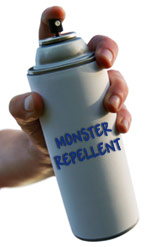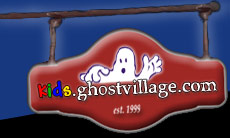Q.L. Pearce has written more than one hundred and twenty books for children, including eight collections of scary stories for middle grade. Q believes strongly in the value of scary books for young readers. When asked what credentials she has which qualify her as an expert in this area she replies, "I was a child once. That was very scary."
By Q.L. Pearce
 In the interest of full disclosure, I write ghost stories. The desk in my home office is usually littered with scary art, and the shelves are stocked with books about ghosts, monsters, and other assorted creepy things. This wasn't an issue until my daughter, Kaitlyn, came along. When she was three years old, Kait began to notice the "scary" things in the house. Since she had a typical childhood fear of the dark and of monsters under the bed or in the closet, I had to make a choice. I could hide my research material, put a lock on my office door, or teach my daughter to be proactive about things that go bump in the night. In the interest of full disclosure, I write ghost stories. The desk in my home office is usually littered with scary art, and the shelves are stocked with books about ghosts, monsters, and other assorted creepy things. This wasn't an issue until my daughter, Kaitlyn, came along. When she was three years old, Kait began to notice the "scary" things in the house. Since she had a typical childhood fear of the dark and of monsters under the bed or in the closet, I had to make a choice. I could hide my research material, put a lock on my office door, or teach my daughter to be proactive about things that go bump in the night.
Of course, every child is different, but if you are faced with this issue, here are a couple of tips that might help. Be respectful of your child's fears. You don't have to overreact or be overprotective, but don't try to laugh it off and never tease. For me, the first step was to address the things that frightened Kait and then reassure her. One of my tools was a can of "monster repellent" on her night table. It was, in fact, a spray can of powder-scented room deodorizer with a home-made label glued on. In the evening we would spray under the bed and in the closet. To this day the smell of baby powder relaxes her!
Don't force a child to dramatically confront a fear. Don't ignore it either. Allowing your child to avoid contact with something that scares them gives a fear the chance to become a real phobia. Talking calmly about the object of your child's fear is one of the best ways to address it. If ghosts are a problem, there are plenty of age-appropriate silly ghost stories that kids can enjoy. When reading a scary story, be sure to approach it as entertainment. As Kait grew older I let her know that people just like me made up the scary stories she read or saw on the television. Sometimes we would make up stories together and if they became too scary we could change direction and make them funny. The important thing is to talk to your child about what they're feeling.
Once my daughter was in upper elementary school, she understood that many people believe that ghosts are real. For parents, the question, "Are ghosts real?" can make a handy teaching moment. It's a good opportunity to talk about tolerance for other people's opinions, about thinking outside of the box, about doing research to learn the facts, and about the value of an open mind.
Now Kait is a teen and she seems to be quite well-adjusted when it comes to those things that go bump in the night. I guess the time has come for me to learn to sleep without a nightlight.
|
|
